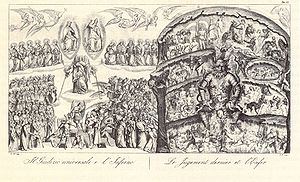
Carlo Lasinio
Encyclopedia

Italy
Italy , officially the Italian Republic languages]] under the European Charter for Regional or Minority Languages. In each of these, Italy's official name is as follows:;;;;;;;;), is a unitary parliamentary republic in South-Central Europe. To the north it borders France, Switzerland, Austria and...
engraver.
He was born at Treviso
Treviso
Treviso is a city and comune in Veneto, northern Italy. It is the capital of the province of Treviso and the municipality has 82,854 inhabitants : some 3,000 live within the Venetian walls or in the historical and monumental center, some 80,000 live in the urban center proper, while the city...
, but worked chiefly at Florence
Florence
Florence is the capital city of the Italian region of Tuscany and of the province of Florence. It is the most populous city in Tuscany, with approximately 370,000 inhabitants, expanding to over 1.5 million in the metropolitan area....
. Lasinio started as a painter at the Accademia, Venice. He quickly placed more emphasis on printmaking, especially after moving to Florence in 1778. He established his reputation with two large series of etchings in 1787 and 1789. Lasinio also taught engraving at the Accademia in Florence, becoming a Professor in 1800.
Lasinio moved to Pisa in 1807, taking up the position of conservatore of the Camposanto. He made considerable efforts to protect the Camposanto and its frescoes from ruin, from which it was threatened due to the destructive effects of the Napoleonic wars
Napoleonic Wars
The Napoleonic Wars were a series of wars declared against Napoleon's French Empire by opposing coalitions that ran from 1803 to 1815. As a continuation of the wars sparked by the French Revolution of 1789, they revolutionised European armies and played out on an unprecedented scale, mainly due to...
. In 1812 he began his influential book of etchings, recording the frescoes in the Camposanto. This was entitled, "Pitture a fresco del Camp Santo di Pisa." These large etchings were composed in the sharply defined "outline style", which was popular in the early nineteenth century in reaction to the soft tonal effects of 18th century stipple engravers such as Francesco Bartolozzi
Francesco Bartolozzi
Francesco Bartolozzi was an Italian engraver, whose most productive period was spent in London.He was born in Florence...
. These works proved to be very influential on 19th century European art, particularly on the Pre-Raphaelites
Pre-Raphaelite Brotherhood
The Pre-Raphaelite Brotherhood was a group of English painters, poets, and critics, founded in 1848 by William Holman Hunt, John Everett Millais and Dante Gabriel Rossetti...
in Britain. According to William Holman Hunt
William Holman Hunt
William Holman Hunt OM was an English painter, and one of the founders of the Pre-Raphaelite Brotherhood.-Biography:...
, study of Lasinio's book convinced the group to reject High Renaissance art in favour of these earlier works. Lasinio's engravings also proved an important record of the frescoes, which were eventually severely damaged by bombing in World War II
World War II
World War II, or the Second World War , was a global conflict lasting from 1939 to 1945, involving most of the world's nations—including all of the great powers—eventually forming two opposing military alliances: the Allies and the Axis...
.
Other works depicting the old masters included his forty plates of Frescoes and Oil Paintings at Florence (1789), large etchings which delineated the most famous Renaissance frescoes in Florence; and thirty-two plates of Frescoes of the Fourteenth and Fifteenth Centuries.
Among his other activities Lasinio also founded the Academy in Pisa, where he died. Apart from his many series of engravings and etchings, Lasinio also created original images. His portrayals of eminent Italians include the great explorers, Christopher Columbus and Amerigo Vespucci.
His son, Giovanni Paolo Lasinio
Giovanni Paolo Lasinio
Giovanni Paolo Lasinio was an Italian engraver.He was the son of the engraver Carlo Lasinio, and together with Rossi engraved forty-four plates of the Campo Santo at Pisa , and took part in the decorations of the Galleries at Florence and Turin. He executed the plates for Ippolito Rosellini's...
, was also an engraver.

